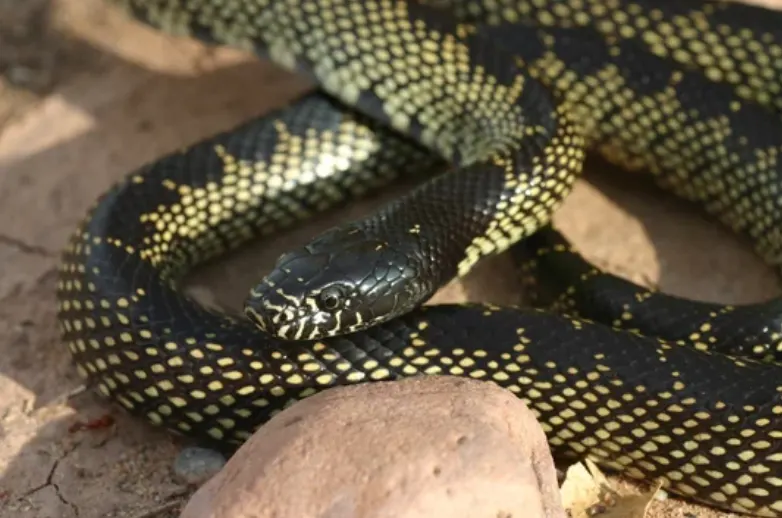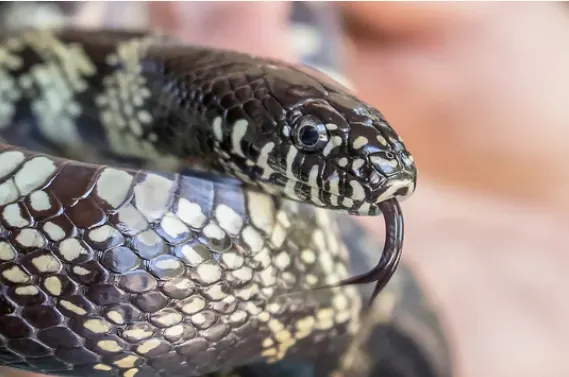The desert kingsnake (Lampropeltis splendida) is one of the most captivating reptiles found in the southwestern United States. Native to Texas, Arizona, and New Mexico, these remarkable creatures have earned a reputation for being non-venomous and non-aggressive, making them an ideal pet choice for reptile enthusiasts. Their striking appearance, coupled with their calm demeanor, makes them both visually interesting and easy to appreciate. Let’s dive into the life of the desert kingsnake and explore what makes this snake truly unique.

Table of Contents
1. Appearance: A Beautiful, Speckled Snake
The desert kingsnake has a distinctive appearance that makes it stand out from other reptiles. It has a glossy black or brown body, with light-colored speckles of white or yellow scattered across its surface. This speckled pattern is not only visually striking but also serves as camouflage in its natural desert habitat.
Their bodies are smooth, with 23-25 rows of dorsal scales that help them glide across the ground with ease. On average, desert kingsnakes grow between 3 to 4 feet long, though some may even reach 5 feet in length. The underside of the snake is primarily black, providing a stark contrast to the speckled patterns on the top.
Occasionally, you may come across albino desert kingsnakes, which are bred for the pet trade. These albino variants are primarily white or pale yellow and tend to be smaller, reaching only about 12 to 14 inches when sold.
2. Habitat: A Desert Dweller
As their name suggests, desert kingsnakes are most commonly found in arid regions. Despite the dry desert terrain, they often seek areas close to water sources, such as rivers or streams. Their geographic range is limited to Texas, Arizona, and New Mexico. Interestingly, while these states are located near Mexico, there have been no confirmed sightings of desert kingsnakes south of the U.S. border.
In the wild, these snakes are primarily nocturnal, coming out during the evening and nighttime hours when temperatures are cooler. This behavior helps them avoid the scorching heat of the desert, which can be detrimental to their survival.
3. Behavior: Docile and Friendly
One of the most remarkable traits of the desert kingsnake is its calm and friendly nature. Unlike many other snakes that may react aggressively when threatened, desert kingsnakes are known to remain passive. If they feel threatened, they often roll over and play dead rather than lash out at potential threats. This behavior, combined with their lack of venom and teeth, makes them relatively harmless to humans.
Because of their gentle demeanor, desert kingsnakes make excellent pets. When kept in captivity, they often form strong bonds with their keepers, even seeking warmth by curling up with them. This affectionate behavior is one of the reasons they are popular among reptile enthusiasts.
4. Diet: Carnivorous Hunters
Desert kingsnakes are carnivores, and their diet consists primarily of small mammals, birds, and reptiles. Interestingly, they are immune to the venom of certain snakes, including rattlesnakes. This unique ability allows them to prey on venomous snakes without fear of being harmed. Their constriction method of hunting involves wrapping their bodies around their prey and squeezing until the prey can no longer breathe.
When kept as pets, desert kingsnakes typically eat 1-2 mice or a medium-sized rat each week. They have no issues consuming frozen or defrosted rodents, making feeding them relatively easy for pet owners. However, hatchlings require smaller prey, such as pinkie mice, which are specially designed for younger snakes.
5. Reproduction: Egg Layers
Desert kingsnakes reproduce by laying eggs. Mating usually occurs between March and June, with females laying clutches of 5-12 eggs. After fertilization, the female often buries the eggs up to 1 foot underground to protect them from the dry desert environment. Burying the eggs helps prevent the shells from drying out, giving the hatchlings a better chance of survival.
In captivity, the temperature must be carefully controlled to mimic the snake’s natural environment, with daytime temperatures between 83-87°F and nighttime temperatures not falling below 68°F.
6. Conservation Status: Least Concern
The desert kingsnake is not considered to be under any immediate threat of extinction. Classified as “Least Concern” on the IUCN Red List, their population is stable, with estimates suggesting over 10,000 individuals across their native range. However, while their numbers remain healthy, their limited geographic range makes them less common than other snake species.
7. Evolutionary History: A Long Line of Kingsnakes
Desert kingsnakes belong to the Colubridae family, which is the largest family of snakes in the world. The earliest known fossils of Colubridae date back to the Cenozoic era, 33 to 23 million years ago. Over time, these snakes migrated from Asia to Europe and eventually found their way to North America. Today, the desert kingsnake is part of the Lampropeltis genus, which includes 26 species of kingsnakes and 45 recognized subspecies. Some of their relatives include the California kingsnake, the common kingsnake, and the scarlet kingsnake.

8. Kingsnakes as Pets: A Popular Choice
For those looking to keep a pet snake, the desert kingsnake is an excellent choice due to its friendly nature and manageable size. With proper care, these snakes can live up to 20 years in captivity. They require fresh water, regular feedings, and a suitable environment with temperatures mimicking their desert home.
Many breeders offer albino variants of desert kingsnakes, providing additional options for enthusiasts who prefer more unusual colorations. No matter the variation, these snakes are a joy to keep and make wonderful companions for reptile lovers.
The desert kingsnake is a fascinating and visually stunning creature with a rich evolutionary history and a friendly temperament. Its adaptability, non-venomous nature, and striking appearance make it a popular pet among reptile enthusiasts. Whether you’re considering keeping one as a pet or simply appreciating them from afar, the desert kingsnake is truly a splendid species worth admiring.
- Enchi Ball Python: A Unique and Stunning Morph of Python regius - March 27, 2025
- Emerald Tree Monitor: The Enigmatic Green Guardian of the Rainforest - March 26, 2025
- The Egyptian Cobra (Naja haje): A Fascinating Serpent - March 25, 2025
